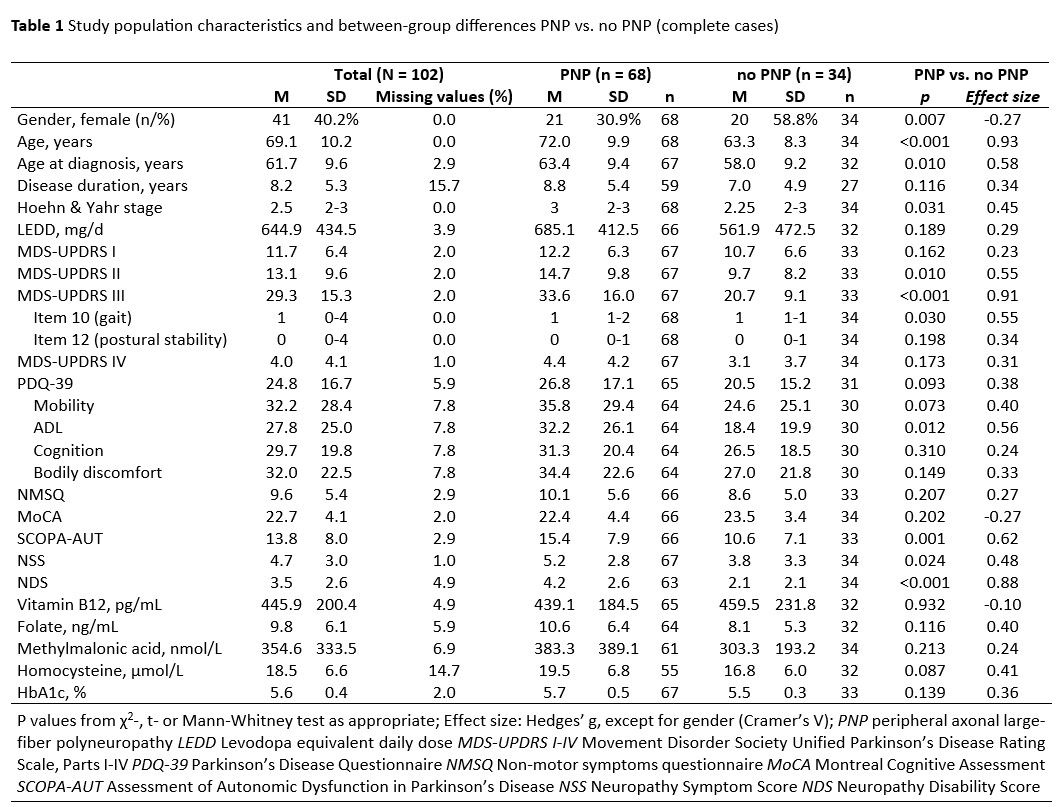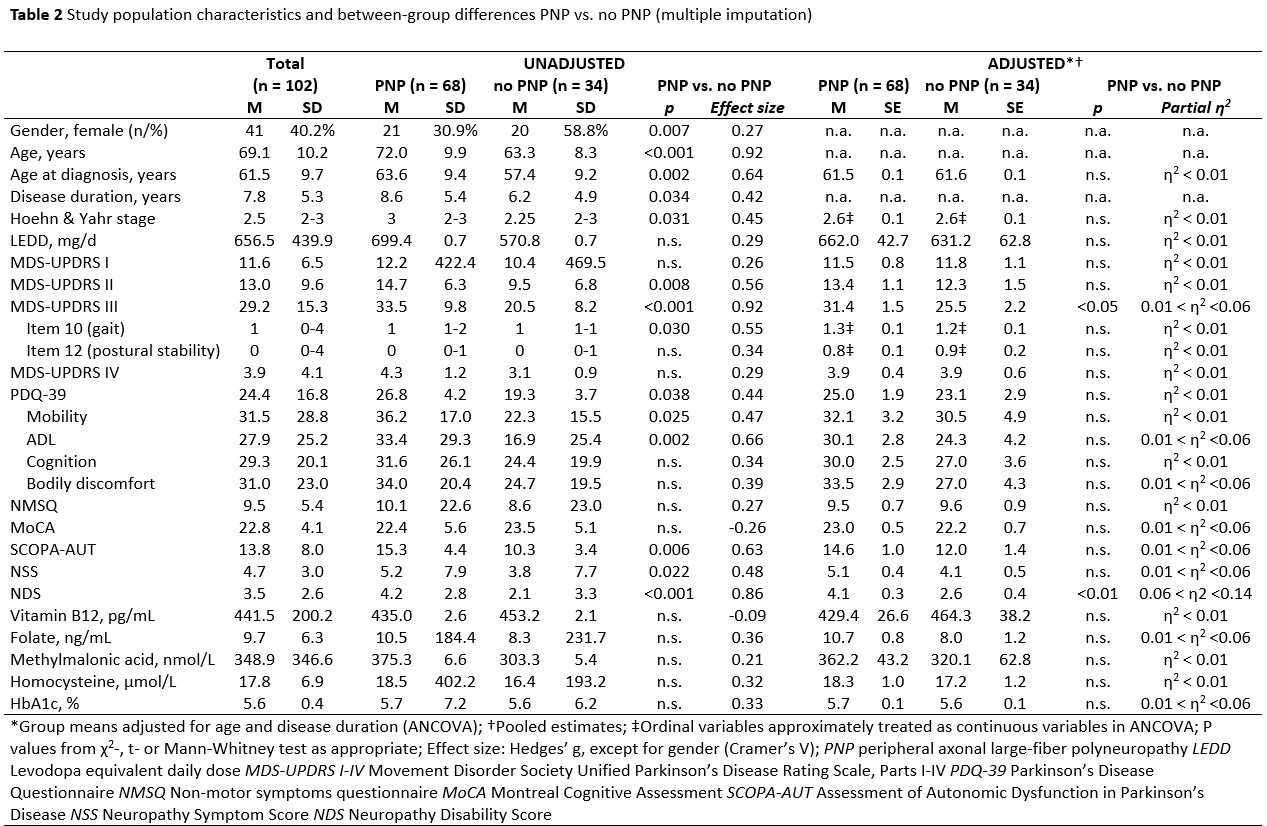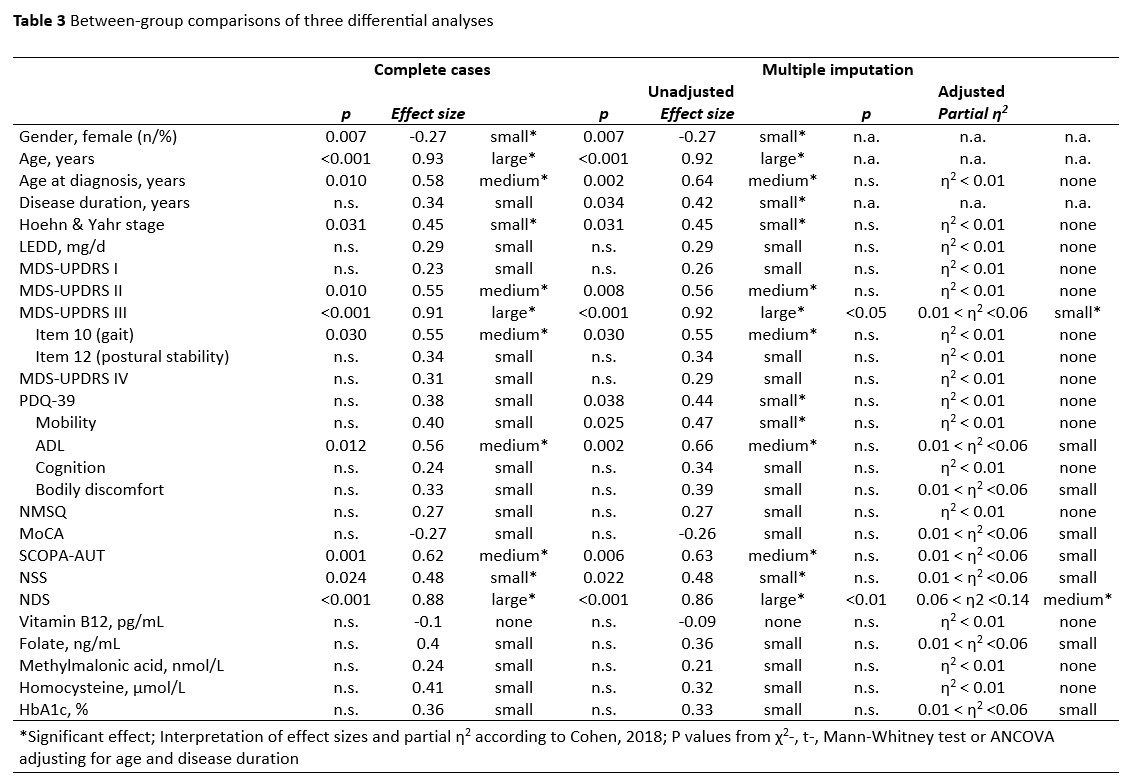Category: Parkinson's Disease: Non-Motor Symptoms
Objective: To describe the prevalence of large-fiber polyneuropathy (PNP) in people with PD and examine differences between subjects with or without PNP.
Background: Non-motor symptoms including sensory features as pain, numbness or proprioceptive deficits significantly impair daily functions and quality of life in people with PD. Comorbidity-independent PNP may contribute to these impairments. Little research has been done on the prevalence and clinical significance of electrophysiologically defined PNP in people with PD.
Method: This cross-sectional analysis of a single-center cohort study [1] included in- and outpatients with PD treated at a university medical center in Germany and excluded subjects with known causes of PNP. Participants were assessed by means of clinical scales and questionnaires [table1] and by bilateral nerve conduction studies (NCS). Axonal PNP was defined by a sensory sural nerve action potential <3.6 mV or compound motor tibial or median nerve action potentials <5 mV [1]. Between-group differences were assessed using χ2-, t- or Mann-Whitney tests, described using effect sizes [2], and adjusted using analysis of covariance (ANCOVA). Multiple imputation with linear regression and five iterations was used to account for missing values.
Results: Of 102 PD subjects with complete NCS data (mean age: 69.1 [± 10.2] years; median HY stage: 2.5 [IQR 2-3]), 68 (66 %) fulfilled the diagnostic criteria of PNP. Compared to non-PNP subjects, PD subjects with PNP were more often male and older, showed higher age at PD diagnosis, higher disease severity as per HY stage and MDS-UPDRS-III score, higher ADL impairment, lower gait capacity, more autonomous involvement and more PNP-related symptoms and disability [table1]. In the imputed analysis set (117 [4 %] imputed of 2754 total values), they additionally showed longer disease duration and lower health-related and mobility-associated quality of life [table2]. When adjusted for age and disease duration, only higher PNP-related disability and Parkinson’s disease severity in the PNP group remained significant [table3].
Conclusion: Large-fiber PNP is highly prevalent in people with PD. PD subjects with PNP show a high burden of motor and non-motor symptoms and disability as well as impaired quality of life which is mainly driven by age. More detailed adjusted risk factors for PNP in PD have to be revealed in further analyses including controls.
References: [1] Kühn, E., Averdunk, P., Huckemann, S., Müller, K., Biesalski, A. S., Hof Zum Berge, F., Motte, J., Fisse, A. L., Schneider-Gold, C., Gold, R., Pitarokoili, K., & Tönges, L. (2020). Correlates of polyneuropathy in Parkinson’s disease. Annals of clinical and translational neurology, 7(10), 1898–1907. https://doi.org/10.1002/acn3.51182
[2] Cohen, J. (2013). Statistical Power Analysis for the Behavioral Sciences. Taylor and Francis.
To cite this abstract in AMA style:
R. Scherbaum, L. Basner, L. Ortmann, J. Steininger, K. Müller, A. Bieber, P. Schülken, J. Motte, A. Fisse, T. Grüter, R. Gold, K. Pitarokoili, L. Tönges. Polyneuropathy in Parkinson’s disease: cross-sectional analysis of the Bochum Parkinson Nerve Study cohort [abstract]. Mov Disord. 2023; 38 (suppl 1). https://www.mdsabstracts.org/abstract/polyneuropathy-in-parkinsons-disease-cross-sectional-analysis-of-the-bochum-parkinson-nerve-study-cohort/. Accessed October 20, 2025.« Back to 2023 International Congress
MDS Abstracts - https://www.mdsabstracts.org/abstract/polyneuropathy-in-parkinsons-disease-cross-sectional-analysis-of-the-bochum-parkinson-nerve-study-cohort/



